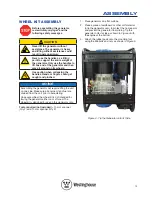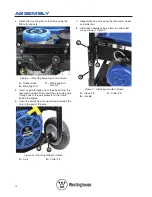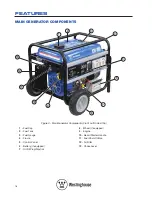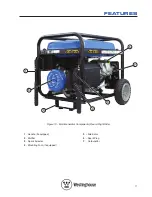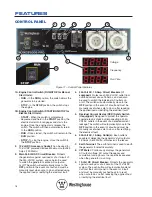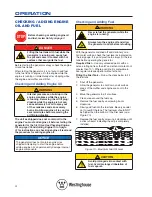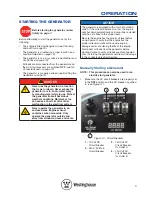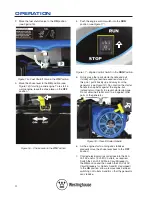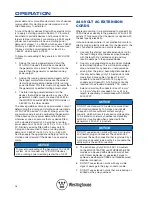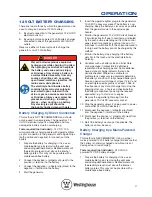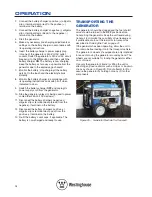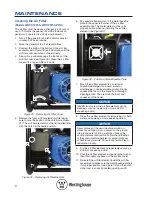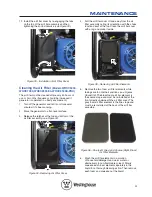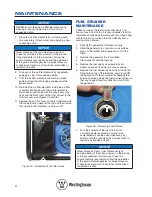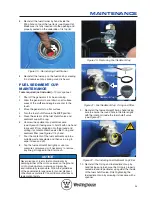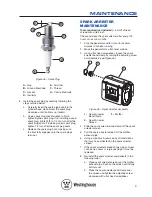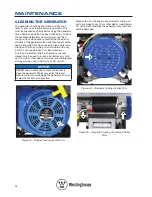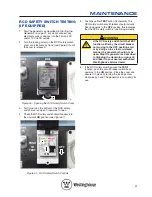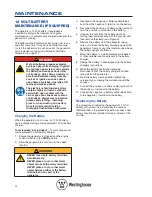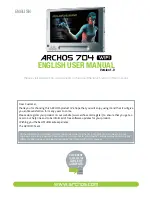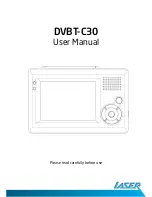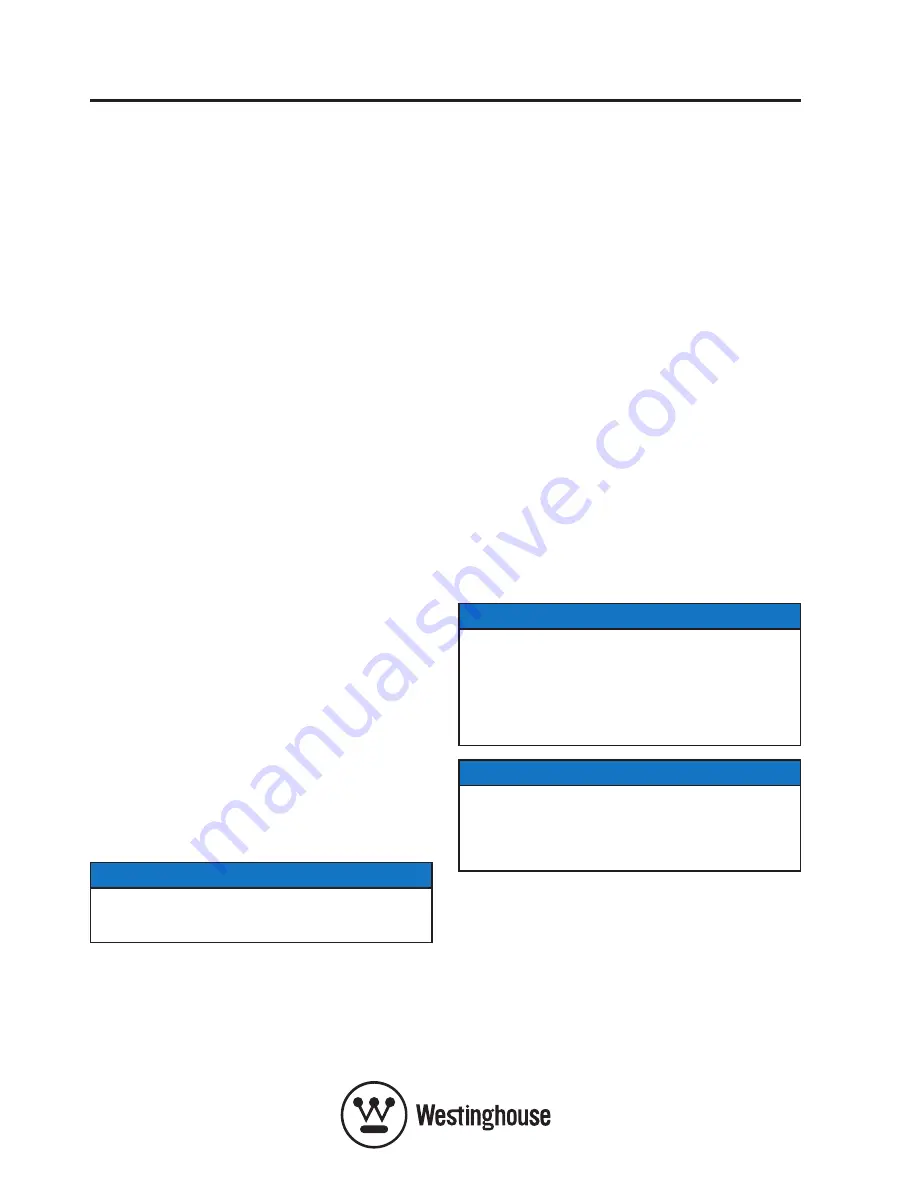
26
OPERATION
power demand or more. Manufacturers of such devices
rarely publish this starting power demand and so it’s
often necessary to estimate it.
A rule of thumb for devices fitted with an electric motor
is to apply a starting power multiplier of 1.2 for small
hand-held or portable devices and a value of 3.5 for
larger stationary devices. For example, a 900 W angle
grinder can be assumed to have a starting power
demand of at least 1.2 × 900 W, which equals 1,080 W.
Similarly, a 1,650 W air compressor can be assumed
to have a starting power demand of at least 3.5 ×
1,650 W, which equals 5,775 W.
To prevent overloading of the generator’s 240-Volt AC
system:
1. Add up the running power demand of all the
240-Volt AC devices that will be connected to
the generator at one time. This total must not be
greater than the generator’s specified running
power output.
2. Add up the running power demand again, but for
the largest motor-driven device use the value of
its starting power demand instead of its running
power demand. This total must not be greater than
the generator’s specified starting power output.
3. The total running power demand of all the
devices that will be connected to any one of the
generator’s outlets must not exceed 3,000 W for
the WHXC3750 and WHXC3750-PRO models or
3,600 W for the other models.
The above guidelines serve as approximations only of
determining the running and starting power demands
of 240-Volt AC devices. If in doubt, always err on the
conservative side to avoid overloading the generator.
In the absence of any power demand information
whatsoever, one can assume that any device fitted
with a standard domestic 10 A plug has a running
power demand of 2,400 W (i.e. 240 V x 10 A = 2,400
W). Similarly a device fitted with a heavy duty 15
A plug can be assumed to have a running power
demand of 3,600 W (i.e. 240 V x 15 A = 3,600 W).
And then apply the appropriate multiplying factor for
starting power demand if the device has an electric
motor.
NOTICE
To prevent overloading of the generator’s 12-Volt DC
system, do not connect any 12-Volt DC device(s)
with a running power demand greater than 100 W.
240-Volt aC EXtEnsion
CorDs
Wherever possible, it is recommended to connect 240-
Volt AC devices directly to the generator’s 240-Volt AC
outlet(s). This ensures that the device is supplied with
the best quality electricity.
In those instances where it’s not practicable or safe to
directly plug an electrical device into the generator, the
use of an electrical extension cord is necessary.
1. Use only the shortest possible extension cord for
the task. Voltage drop increases proportionately
with the length of an extension cord and may
result in damage to the powered device.
2. Use only a single extension cord and not multiple
cords joined together. This will minimize voltage
drop and prevent any hazard or inconvenience
arising from the joint(s) becoming disconnected.
3. Use only extra heavy duty 15 A extension cords
made from 3-core cable of at least 1.5 mm
2
conductor size and fitted with 15 A plugs and
sockets (see Figure 23). A 15 A plug cannot be
inserted into a standard domestic 10 A socket.
4. Extension cords with conductor size of 1.5 mm
2
or 2.5 mm
2
should not exceed 31 m or 51 m in
length, respectively, in accordance with AS/NZS
3000:2007.
NOTICE
DO NOT use standard 10 A extension cords fitted
with standard domestic 10 A plugs and sockets.
These do not have sufficient current carrying
capacity, which will result in excessive voltage drop.
10 A extension cords may overheat and possibly
catch fire if overloaded when connected to the
generator’s 240-Volt 15 A outlets.
NOTICE
DO NOT use extension cords with only 2-pin (active
and neutral) plugs and sockets. These extension
cords lack the earth connection that is provided by a
3-pin plug and socket joined with a 3-core cable; the
vertical pin is the earth connection.
5. The extra heavy duty 240-Volt AC 15 A outlets
on the WHXC3750-PRO and WHXC8500E-PRO
models can be used with extension cords fitted
with Clipsal 56-Series (or equivalent) plugs to
achieve a weatherproof IP66 and thread-secured
electrical connection.
6. DO NOT use extension cords with any visible
signs of damage to the plug, socket or cable.
7. DO NOT use extension cords that are rolled up or
knotted as they may overheat.
Summary of Contents for WHXC3750
Page 4: ...4...
Page 55: ...55 NOTES...


